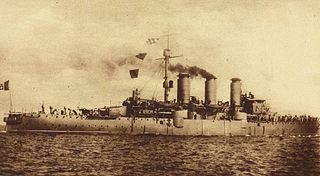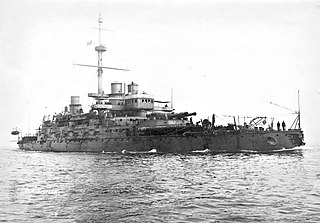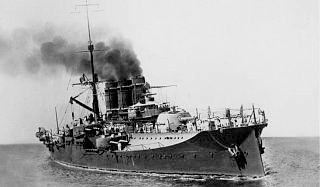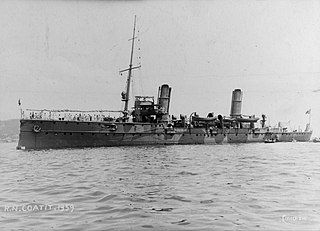
The Regina Margherita class was a class of two battleships built for the Italian Regia Marina between 1898 and 1905. The class comprised two ships: Regina Margherita and Benedetto Brin. The ships were designed by the latter's namesake, Benedetto Brin, who died before the ships were completed. They were armed with a main battery of four 12 in (305 mm) guns and could steam at a speed of 20 knots.

Enrico Dandolo was the second of two Duilio-class ironclad turret ships built for the Italian Regia Marina in the 1870s. They were fitted with the largest guns available, 450 mm (18 in) rifled, muzzle-loading guns, and were the largest, fastest and most powerful ships of their day. Enrico Dandolo was built in La Spezia, with her keel laid in January 1873 and her hull launched in July 1878. Construction was finally completed in April 1882 when the ship, named for the 41st Doge of Venice, was commissioned into the Italian fleet.

The Francesco Caracciolo-class battleships were a group of four super-dreadnought battleships designed for the Regia Marina in 1913 and ordered in 1914. The first ship of the class, Francesco Caracciolo, was laid down in late 1914; the other three ships, Cristoforo Colombo, Marcantonio Colonna, and Francesco Morosini followed in 1915. Armed with a main battery of eight 381 mm (15 in) guns and possessing a top speed of 28 knots, the four ships were intended to be the equivalent of the fast battleships like the British Queen Elizabeth class.

Regina Margherita was the lead ship of her class of pre-dreadnought battleships built for the Italian Regia Marina between 1898 and 1904. She had one sister ship, Benedetto Brin. Regina Margherita saw action in the Italo-Turkish War of 1911–1912. By the outbreak of World War I in 1914, the battleship had been reduced to a training ship. She struck two naval mines on the night of 11–12 December 1916 while steaming off Valona. She sank with heavy loss of life: 675 men were killed, and only 270 survived.

Benedetto Brin was a Regina Margherita-class pre-dreadnought battleship built for the Italian Regia Marina between 1899 and 1905. The ship was armed with a main battery of four 12-inch (300 mm) guns and was capable of a top speed of 20 knots. Benedetto Brin saw combat in the Italo-Turkish War of 1911–1912, including the bombardment of Tripoli in October 1911. She was destroyed by an internal explosion during World War I in September 1915, which killed over 450 of the ship's crew.

Amalfi was a Pisa-class armored cruiser of the Italian Royal Navy built in the first decade of the 20th century. During the Italo-Turkish War of 1911–1912, Amalfi operated with the Italian fleet off Tripoli in September 1911 and participated in the amphibious landings at Derna in October. In April 1912, Amalfi and sister ship Pisa led the way in attacks on Turkish forts in the Dardanelles. After the rest of the fleet retired later in the month, the pair of armored cruisers remained in the area to attack Turkish communications facilities. After the Treaty of Lausanne signed in October 1912 ended the war, Amalfi escorted the Italian king and queen on the royal yacht to Germany and Sweden during a 1913 visit.

Ammiraglio di Saint Bon was a pre-dreadnought battleship of the Italian Regia Marina built during the 1890s. She was laid down in July 1893, launched in April 1897, and completed in May 1901. She was the lead ship of her class, and had one sister ship, Emanuele Filiberto. The ship was armed with a main battery of four 254 mm (10 in) guns and was capable of a top speed of 18 knots.

The Re Umberto class were a group of three ironclad battleships built for the Italian Navy in the 1880s and 1890s. The ships—Re Umberto, Sicilia, and Sardegna—were built as the culmination of a major naval expansion program begun in the 1870s following Italy's defeat at the Battle of Lissa in 1866. The Re Umbertos incorporated several innovations over previous Italian designs, including a more efficient arrangement of the main battery, installation of wireless telegraphs, and in Sardegna, the first use of triple-expansion steam engines in an Italian capital ship. Designed by Benedetto Brin, they retained the very thin armor protection and high top speeds of his earlier designs.

Re Umberto was a Re Umberto-class ironclad battleship built for the Italian Regia Marina in the 1880s, the lead ship of her class. She was laid down in July 1884 and launched in October 1888; work proceeded so slowly that she was not finished until February 1893. She was armed with a main battery of four 343 mm (13.5 in) guns and had a top speed of 20.3 knots, though this high speed came at the cost of armor protection.

Sicilia was the second of three Re Umberto-class ironclad battleships built for the Italian Regia Marina. The ship, named for the island of Sicily, was laid down in Venice in November 1884, launched in July 1891, and completed in May 1895. She was armed with a main battery of four 343 mm (13.5 in) guns and had a top speed of 20.3 knots, though this high speed came at the cost of armor protection.

Sardegna was the third of three Re Umberto-class ironclad battleships built for the Italian Regia Marina. The ship, named for the island of Sardinia, was laid down in La Spezia in October 1885, launched in September 1890, and completed in February 1895. She was armed with a main battery of four 340 mm (13.5 in) guns and had a top speed of 20.3 knots —albeit at the cost of armor protection—and she was one of the first warships to be equipped with a wireless telegraph.

The Regina Elena class was a group of four pre-dreadnought battleships built for the Italian Regia Marina between 1901 and 1908. The class comprised four ships: Regina Elena, the lead ship, Vittorio Emanuele, Roma, and Napoli. Designed by Vittorio Cuniberti, they were armed with a main battery of two 12-inch (305 mm) guns and twelve 8 in (203 mm) guns, and were capable of a top speed of 22 knots. They were the fastest battleships in the world at the time of their commissioning, faster even than the British turbine-powered HMS Dreadnought.

The Emanuele Filiberto was a pre-dreadnought battleship built for the Italian Regia Marina during the 1890s. Her keel was laid down in October 1893 and she was launched in September 1897; work was completed in April 1902. She had one sister ship, Ammiraglio di Saint Bon, the lead ship of the Ammiraglio di Saint Bon class. She was armed with a main battery of four 254 mm (10 in) guns and was capable of a speed in excess of 18 knots.

Regina Elena was the lead ship of her class of pre-dreadnought battleships built for the Italian Regia Marina. The ship was built by the La Spezia shipyard between 1901 and 1907, and was armed with a main battery of two 305 mm (12 in) guns and twelve 203 mm (8 in) guns. She was quite fast for the period, with a top speed of nearly 21 knots. Regina Elena was active in both the Italo-Turkish War with the Ottoman Empire in 1911–1912, where she participated in the Italian conquest of Cyrenaica, and World War I in 1915–1918, where she saw no action due to the threat of submarines in the narrow confines of the Adriatic Sea. She was retained for a few years after the war, but was ultimately stricken in February 1923 and broken up for scrap.

Vittorio Emanuele was an Italian pre-dreadnought battleship, laid down in 1901, launched in 1904 and completed in 1908. She was the second member of the Regina Elena class, which included three other vessels: Regina Elena, Napoli, and Roma. Vittorio Emmanuele was armed with a main battery of two 305 mm (12 in) guns and twelve 203 mm (8 in) guns. She was quite fast for the period, with a top speed of nearly 21 knots.

Roma was an Italian pre-dreadnought battleship, laid down in 1903, launched in 1907 and completed in 1908. She was the third member of the Regina Elena class, which included three other vessels: Regina Elena, Napoli, and Vittorio Emanuele. Roma was armed with a main battery of two 305 mm (12 in) guns and twelve 203 mm (8 in) guns. She was quite fast for the period, with a top speed of nearly 21 knots.

Napoli was a Regina Elena-class pre-dreadnought battleship built for the Italian Regia Marina in 1903–08. She was the last member of the four-ship class, which included the lead ship Regina Elena, Vittorio Emanuele, and Roma. Napoli was armed with a main battery of two 305 mm (12 in) and twelve 203 mm (8 in) guns, and was capable of a top speed of 21 knots.

Coatit was a torpedo cruiser of the Italian Regia Marina built in the late 1890s. She was the second and final member of the Agordat class. The ship, which was armed with twelve 76 mm (3 in) guns and two 450 mm (17.7 in) torpedo tubes, was too slow and short-ranged to be able to scout effectively for the fleet, so her career was limited. She saw action during the Italo-Turkish War in 1911–1912, where she provided gunfire support to Italian troops in North Africa. She also caused a minor diplomatic incident from an attack on retreating Ottoman soldiers in Anatolia. Coatit was part of an international fleet sent to Constantinople when the city appeared to be at risk of falling to the Bulgarian Army during the First Balkan War. In 1919, she was converted into a minelayer and was sold for scrap in 1920.

The Italian cruiser Vettor Pisani was the name ship of her class of two armored cruisers built for the Royal Italian Navy in the 1890s. She often served as a flagship during her career and frequently served overseas. On one of these deployments, the ship received a radio message from Peking, one of the first long-range radio transmissions to a ship. Vettor Pisani participated in the Boxer Rebellion of 1900 and the Italo-Turkish War of 1911–12, during which her admiral nearly caused a diplomatic incident with the Austro-Hungarian Empire. During World War I, her activities were limited by the threat of Austro-Hungarian submarines and she was converted into a repair ship in 1916. Vettor Pisani was stricken from the Navy List in 1920 and scrapped later that year.


















